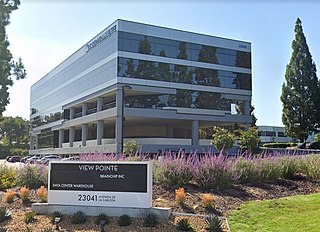
HRL Laboratories is a research center in Malibu, California, established in 1960. Formerly the research arm of Hughes Aircraft, HRL is currently owned by General Motors Corporation and Boeing. The research facility is housed in two large, white multi-story buildings overlooking the Pacific Ocean.

Synopsys is an American electronic design automation (EDA) company headquartered in Sunnyvale, California, that focuses on silicon design and verification, silicon intellectual property and software security and quality. Synopsys supplies tools and services to the semiconductor design and manufacturing industry. Products include tools for logic synthesis and physical design of integrated circuits, simulators for development, and debugging environments that assist in the design of the logic for chips and computer systems. As of 2023, the company is a component of both the Nasdaq-100 and S&P 500 indices.
Neuromorphic computing is an approach to computing that is inspired by the structure and function of the human brain. A neuromorphic computer/chip is any device that uses physical artificial neurons to do computations. In recent times, the term neuromorphic has been used to describe analog, digital, mixed-mode analog/digital VLSI, and software systems that implement models of neural systems. The implementation of neuromorphic computing on the hardware level can be realized by oxide-based memristors, spintronic memories, threshold switches, transistors, among others. Training software-based neuromorphic systems of spiking neural networks can be achieved using error backpropagation, e.g., using Python based frameworks such as snnTorch, or using canonical learning rules from the biological learning literature, e.g., using BindsNet.
An artificial brain is software and hardware with cognitive abilities similar to those of the animal or human brain.

Interuniversity Microelectronics Centre (IMEC) is an international research & development organization, active in the fields of nanoelectronics and digital technologies with headquarters in Belgium. Luc Van den hove has served as President and CEO since 2009.

VIB is a research institute located in Flanders, Belgium. It was founded by the Flemish government in 1995, and became a full-fledged institute on 1 January 1996. The main objective of VIB is to strengthen the excellence of Flemish life sciences research and to turn the results into new economic growth. VIB spends almost 80% of its budget on research activities, while almost 12% is spent on technology transfer activities and stimulating the creation of new businesses, in addition VIB spends approximately 2% on socio-economic activities. VIB is member of EU-LIFE, an alliance of leading life sciences research centres in Europe.
The Computer Security and Industrial Cryptography research group, commonly called COSIC, is a research group at the Department of Electrical Engineering of KU Leuven, which is headed by Bart Preneel.

Rudi Pauwels is a Belgian pharmacologist and biotech entrepreneur.
The Arenberg Research-Park is a science park founded by the KU Leuven in 2004. The science park is in the immediate vicinity of the Arenberg campus of the university in Heverlee (Belgium), UZ Leuven campus Gasthuisberg and IMEC. The park is 13 hectares and consists of different cluster-areas, with amongst others a bio-incubator for spin-offs of the university and space for companies active in research and development.

Massimiliano Versace is the co-founder and the CEO of Neurala Inc, a Boston-based company building Artificial Intelligence emulating brain function in software and used in automating the process of visual inspection in manufacturing. He is also the founding Director of the Boston University Neuromorphics Lab. Massimiliano Versace is a Fulbright scholar and holds two PhD in Experimental Psychology from the University of Trieste, Italy and Cognitive and Neural Systems from Boston University, USA. He obtained his BSc from the University of Trieste, Italy.

Sanjiv Rai is a first-generation Indian innovator and serial entrepreneur. He is the Founder, Chairperson and Chief Solver of multiple startups under Billion Innovators and Chairperson at ARE Technologies and his venture initiatives AceWP Innovation Labs and BillionInnovators intend to promote innovation in India and abroad. As a serial Entrepreneur or Innovator he has worked on AI based convergence and design algorithms, on a variety of products and solutions such as network convergence enabling D5 chip, AceWP, PlasmaPHI, innovate2learn, agniie devices, ChazeMe, SmartSAPS(Smart Secured Automated Payment Solutions), coolATM and Rosenbridges Future Cities/Smart Buildings and CHANDRA project for NASA towards permanent human inhabitancy on outer planets.
The IEEE International Electron Devices Meeting (IEDM) is an annual micro- and nanoelectronics conference held each December that serves as a forum for reporting technological breakthroughs in the areas of semiconductor and related device technologies, design, manufacturing, physics, modeling and circuit-device interaction.
Google Brain was a deep learning artificial intelligence research team under the umbrella of Google AI, a research division at Google dedicated to artificial intelligence. Formed in 2011, Google Brain combined open-ended machine learning research with information systems and large-scale computing resources. The team has created tools such as TensorFlow, which allow for neural networks to be used by the public, with multiple internal AI research projects. The team aims to create research opportunities in machine learning and natural language processing. The team was merged into former Google sister company DeepMind to form Google DeepMind in April 2023.

DeepMind Technologies Limited, doing business as Google DeepMind, is a British-American artificial intelligence research laboratory which serves as a subsidiary of Google. Founded in the UK in 2010, it was acquired by Google in 2014, The company is based in London, with research centres in Canada, France, Germany and the United States.
An AI accelerator is a class of specialized hardware accelerator or computer system designed to accelerate artificial intelligence and machine learning applications, including artificial neural networks and machine vision. Typical applications include algorithms for robotics, Internet of Things, and other data-intensive or sensor-driven tasks. They are often manycore designs and generally focus on low-precision arithmetic, novel dataflow architectures or in-memory computing capability. As of 2018, a typical AI integrated circuit chip contains billions of MOSFET transistors. A number of vendor-specific terms exist for devices in this category, and it is an emerging technology without a dominant design.
Google AI is a division of Google dedicated to web browser. It was announced at Google I/O 2017 by CEO Sundar Pichai.
Chris Van Hoof is a full professor at KU Leuven’s Faculty of Engineering Science, Vice-President Connected Health Solutions and Fellow at IMEC, and general manager of OnePlanet Research Center.
Ingrid Verbauwhede is a professor at the COSIC Research Group of the Electrical Engineering Department, KU Leuven, where she leads the embedded systems team. She is a pioneer in the field of secure embedded circuits and systems, with several awards recognising her contributions to the field. She is member of the Royal Flemish Academy of Belgium for Science and the Arts since 2011. She is a fellow of IEEE.
Neuropixels probes are electrodes developed in 2017 to record the activity of hundreds of neurons in the brain. The probes are based on CMOS technology and have 1,000 recording sites arranged in two rows on a thin, 1-cm long shank.

BrainChip is an Australia-based technology company, founded in 2004 by Peter Van Der Made, that specializes in developing advanced artificial intelligence (AI) and machine learning (ML) hardware. The company's primary products are the MetaTF development environment, which allows the training and deployment of spiking neural networks (SNN), and the AKD1000 neuromorphic processor, a hardware implementation of their spiking neural network system. BrainChip's technology is based on a neuromorphic computing architecture, which attempts to mimic the way the human brain works. The company is a part of Intel Foundry Services and Arm AI partnership.








